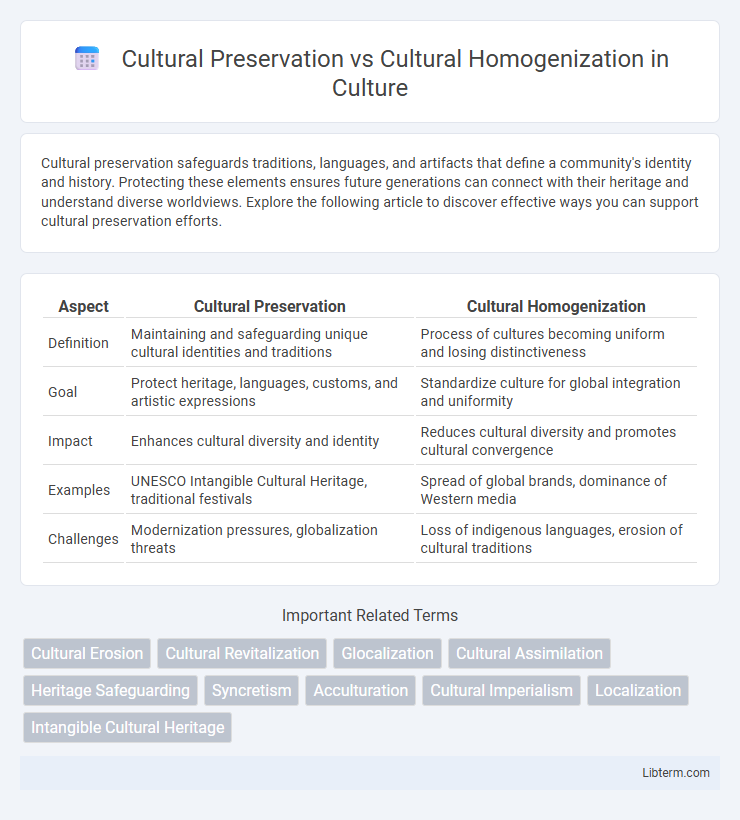Cultural preservation safeguards traditions, languages, and artifacts that define a community's identity and history. Protecting these elements ensures future generations can connect with their heritage and understand diverse worldviews. Explore the following article to discover effective ways you can support cultural preservation efforts.
Table of Comparison
| Aspect | Cultural Preservation | Cultural Homogenization |
|---|---|---|
| Definition | Maintaining and safeguarding unique cultural identities and traditions | Process of cultures becoming uniform and losing distinctiveness |
| Goal | Protect heritage, languages, customs, and artistic expressions | Standardize culture for global integration and uniformity |
| Impact | Enhances cultural diversity and identity | Reduces cultural diversity and promotes cultural convergence |
| Examples | UNESCO Intangible Cultural Heritage, traditional festivals | Spread of global brands, dominance of Western media |
| Challenges | Modernization pressures, globalization threats | Loss of indigenous languages, erosion of cultural traditions |
Defining Cultural Preservation and Cultural Homogenization
Cultural preservation refers to the active efforts to maintain and protect the unique traditions, languages, arts, and customs of specific communities, ensuring their transmission to future generations. Cultural homogenization involves the process by which local cultures become increasingly similar due to globalization, mass media, and dominant cultural influences, often leading to the erosion of cultural diversity. The tension between these concepts highlights the challenge of safeguarding cultural identities amid growing global interconnectedness.
Historical Context of Cultural Change
Historical context of cultural change reveals that cultural preservation efforts emerged as a response to colonialism, globalization, and industrialization, which often threatened indigenous traditions and identities. Cultural homogenization accelerated during periods of mass communication and economic integration, promoting dominant cultural norms at the expense of local diversity. Understanding these historical dynamics is essential for addressing the tension between maintaining unique cultural heritages and the forces driving global cultural uniformity.
The Impact of Globalization on Local Cultures
Globalization accelerates cultural homogenization by promoting dominant cultural norms through media, commerce, and technology, often overshadowing local traditions. The pervasive influence of multinational corporations and digital platforms reshapes local identities, risking the erosion of unique languages, rituals, and customs. Efforts to preserve cultural heritage involve safeguarding intangible cultural assets, promoting indigenous knowledge, and reinforcing community-based cultural practices against global standardization.
Media Influence: Spreading or Standardizing Cultures
Media significantly drives cultural homogenization by promoting dominant global narratives that often overshadow local traditions and languages. The widespread distribution of mainstream movies, music, and social platforms fosters shared experiences but can dilute unique cultural identities. Preserving diverse cultural expressions requires intentional media representation and support for indigenous content creators to counterbalance standardizing influences.
Economic Drivers of Cultural Homogenization
Economic globalization drives cultural homogenization by promoting standardized products and services that cater to global markets, often diminishing local traditions and unique cultural identities. Multinational corporations influence cultural consumption patterns through mass media, advertising, and franchises, encouraging uniformity in tastes and lifestyles worldwide. The pursuit of economic efficiency and profitability frequently undermines cultural diversity as local customs are commercialized or replaced to appeal to broader audiences.
The Role of Education in Shaping Cultural Identity
Education plays a pivotal role in shaping cultural identity by promoting awareness and appreciation of diverse traditions, languages, and histories within curricula. Incorporating culturally responsive teaching methods helps preserve unique cultural narratives while resisting the pressures of cultural homogenization driven by globalization and standardized education models. Schools that prioritize inclusive educational content contribute to sustaining cultural diversity and empowering communities to maintain their distinct heritage.
Government Policies for Protecting Cultural Heritage
Government policies for protecting cultural heritage play a crucial role in balancing cultural preservation and cultural homogenization. Laws such as UNESCO's World Heritage Convention empower governments to safeguard historic sites, traditional practices, and indigenous languages from erosion caused by globalization. Effective cultural policy frameworks include funding for museums, education programs, and community-based initiatives that promote cultural diversity while resisting homogenizing global forces.
Indigenous Cultures vs Modernization
Indigenous cultures face significant risks of erosion due to rapid modernization and the spread of globalized cultural norms, leading to cultural homogenization. Efforts in cultural preservation emphasize safeguarding traditional languages, customs, and knowledge systems to maintain unique cultural identities and resist assimilation pressures. Balancing technological advancement with respect for indigenous heritage is crucial to ensure that modernization does not erase centuries-old cultural practices and worldviews.
Success Stories in Cultural Preservation
Indigenous communities in New Zealand have successfully revitalized the Maori language through government-backed programs like Te Wiki o te Reo Maori (Maori Language Week), significantly increasing fluent speakers. In Guatemala, the preservation of Mayan traditions is upheld by integrating indigenous knowledge into education and protecting sacred sites, fostering cultural pride among younger generations. Japan's efforts to maintain traditional crafts such as kimono weaving and taiko drumming involve local artisans and government support, ensuring these cultural expressions remain vibrant and economically viable.
Balancing Progress with Cultural Diversity
Balancing progress with cultural diversity involves protecting unique traditions and languages while embracing technological and economic advancements. Efforts in cultural preservation support the maintenance of indigenous knowledge systems and local customs, providing a counterweight to cultural homogenization driven by globalization. Sustainable development policies must integrate cultural diversity to foster inclusive growth without eroding distinct cultural identities.
Cultural Preservation Infographic

 libterm.com
libterm.com